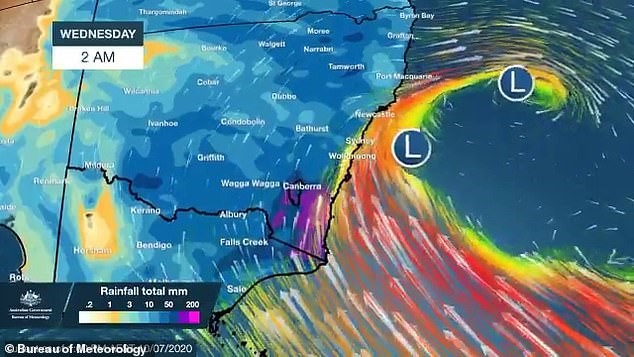East Coast Low Australia (Bureau of Meteorology, Australia)
Strong southerly winds, when combined with an easterly swell, can create extreme wave conditions where container ships are at risk of losing cargo overboard. In such incidents, swell size and interval may lead to excessive or even parametric rolling resulting in extreme acceleration forces on container stacks.
Guidance for avoidance of parametric rolling is provided in MSC.1/Circ.1228 Revised guidance to the master for avoiding dangerous situations in adverse weather and sea conditions.
Chapter 6.3 of the CSS states:
“One way of reducing excessive accelerations is for the master, as far as possible and practicable, to plan the voyage of the ship carefully so as to avoid areas with severe weather and sea conditions. The master should always consult the latest available weather information.”
The Australian Government Bureau of Meteorology (BoM) provides weather forecasts and high seas warnings to GMDSS equipped ships in Australian waters, these are received by Inmarsat C or Iridium Terminals configured to NAVAREA X.
Cargo securing manual
Cargo containers shall be stowed and secured in accordance with the approved Cargo Securing Manual as required by Regulation 5.6 of Chapter VI of SOLAS.
Masters and deck officers must be familiar with the contents of the Cargo Securing Manual including container securing requirements, maximum container stack masses and permissible vertical sequences of masses within container stacks.
Exceeding the mass limits defined in the Cargo Securing Manual may result in the destruction of lashings and fittings or the collapse of individual containers due to excessive acceleration forces in heavy weather.
Maintenance of securing devices and arrangements
Using heavily corroded fixed or portable cargo securing devices increases the risk of container loss as this diminishes the Maximum Securing Load (MSL).




 Ningbo Containerized Freight Index Weekly Commentar
Ningbo Containerized Freight Index Weekly Commentar  Ningbo Containerized Freight Index Weekly Commentar
Ningbo Containerized Freight Index Weekly Commentar  Ningbo Containerized Freight Index Weekly Commentar
Ningbo Containerized Freight Index Weekly Commentar  BIMCO Shipping Number of the Week: Bulker newbuildi
BIMCO Shipping Number of the Week: Bulker newbuildi  Ningbo Containerized Freight Index Weekly Commentar
Ningbo Containerized Freight Index Weekly Commentar  Ningbo Containerized Freight Index Weekly Commentar
Ningbo Containerized Freight Index Weekly Commentar